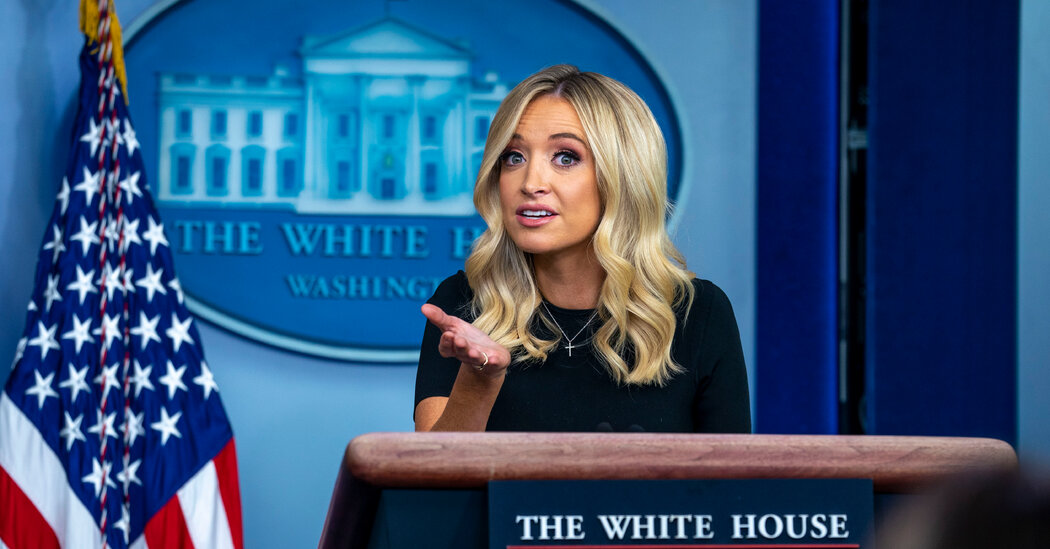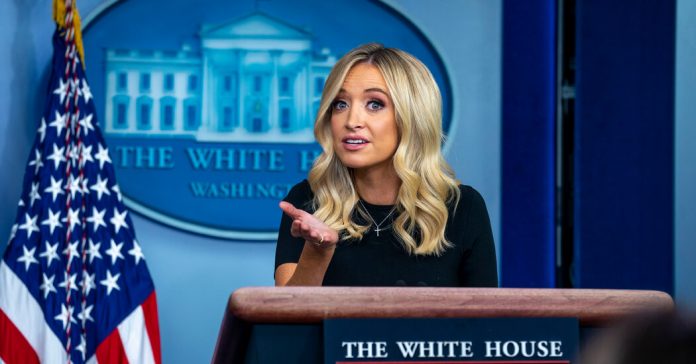
WASHINGTON — For the first half of his term, President Trump treated the White House press briefing as must-see television. From his small dining room off the Oval Office, he kept close watch over his first two press secretaries as they battled with journalists, defended his performance and often tried to rewrite history.
Kayleigh McEnany, the fourth person to hold the job since Mr. Trump took office, does all of those things. The difference now is that the president, who once considered the White House briefings to be appointment television, does not always watch.
Just over 13 weeks from Election Day, Mr. Trump is back to serving as his own primary spokesman, putting his faith in himself to pull out of a deep polling hole and make the case for why voters should choose to give him four more years despite his mishandling of the coronavirus pandemic and a brutal recession.
Whether he is helping himself is subject to debate. But his decision to put himself front and center on a near-daily basis has left Ms. McEnany in a distinctly secondary role. Not only has her audience of one failed to watch a number of her briefings in recent weeks — a senior administration official suggested on Friday that the president was busy with other matters — she has also encountered flagging interest from television networks; only Fox News regularly carries her briefings live, and at least one network has declined a request to have her appear on one of its shows.
All of that is leaving it increasingly unclear what purpose Ms. McEnany is filling beyond berating the news media from the briefing room podium.
When Ms. McEnany, 32, assumed the role in April, Mr. Trump was delivering two-hour briefings on the coronavirus pandemic. At the time, questions were raised internally about whether Ms. McEnany should start formalized briefings or continue defending the president through television appearances — she initially made a name for herself in his world by defending him on CNN, a network where he has few allies.
In April, her new colleagues also wondered how Ms. McEnany, an operative known for overtly partisan and often fact-free defenses of the president, would fare in the White House, which is supposed to separate official business from campaign operations — at least in theory.
If that was ever a concern for Ms. McEnany or anyone else on staff, it never showed. Working with Mark Meadows, the White House chief of staff, and several of the officials he brought with him when he joined the administration in March, Ms. McEnany reinstated the briefings, which had been stopped under her predecessor, Stephanie Grisham. Ms. McEnany infused them with campaign-style talking points and edited videos of news clips, some of which were stripped of context.
Instead of bringing the public health experts involved in the coronavirus response with her to the podium so that reporters could ask them questions, she spoke to them herself beforehand.
Early in Ms. McEnany’s tenure, she was praised by conservative news media for her attacks on the mainstream press. But since then, she has so far struggled to make the briefings compelling enough — or credible enough — to refocus the attention on what the administration hopes to highlight instead of the pandemic. She recently resorted to playing a video of protesters in Portland, Ore., that she accused the news media of ignoring. The video contained explicit language, causing Fox News, which faithfully airs the briefings, to cut away.
“We were not expecting that video, and our management here at Fox News has decided we will cut away at this time,” the host, Harris Faulkner, said.
Ms. McEnany is hardly the first Trump press secretary to criticize the news media, or to say things from the podium that are untrue.
Sean Spicer, the first to hold the job under Mr. Trump, started out by trying to persuade incredulous reporters and the nation that the Inauguration Day crowd size set an attendance record. (It didn’t.) Sarah Huckabee Sanders refused to disavow Mr. Trump’s claim that journalists were the enemies of the people. And Ms. Grisham, who never held a briefing, preferred using Twitter to call out journalists by name.
But for all that, Ms. McEnany’s predecessors also understood the value in working with reporters, even when it was not something Mr. Trump encouraged.
Jonathan Karl of ABC News, the former president of the White House Correspondents’ Association, criticized Ms. McEnany’s tendency to fill the press briefings with “head-spinning contradictions” and her lack of interest in clarifying Mr. Trump’s decisions, particularly on matters of race.
“The White House press secretary serves at the pleasure of a president but is also a public servant whose salary is paid by taxpayers,” Mr. Karl wrote in a Washington Post op-ed in July. “Denying reality and using the White House podium for purely political purposes is a violation of public trust.”
Ms. McEnany has taken the adversarial posture to a new level. At one point, she insinuated that reporters were adverse to religion by saying journalists were “desperately” opposed to houses of worship reopening during the pandemic.
Ari Fleischer, who served as press secretary during the administration of President George W. Bush, praised Ms. McEnany’s performance but said she had demonstrated little interest in forging a relationship with the press. He said her tendency of “hitting the press with a two-by-four” risked overshadowing any substantive contributions.
“The press secretaries have always served two masters, as the old adage goes,” Mr. Fleischer said. “But these days, the president is way bigger than the press in reality of how the briefing works.”
Mike McCurry, who served as press secretary under President Bill Clinton, said that Ms. McEnany only seemed to be interested in serving as a partisan booster for the president.
“There’s got to be a balance between providing information and content that is useful to the public while advancing whatever the president’s political objectives are,” Mr. McCurry said. “You kind of have to keep both of those goals in mind.”
The White House disputed the idea that Ms. McEnany did not work with reporters, but officials said she spent most of her time with the president, maintaining that is what she should be doing as his chief spokeswoman. Officials said that no cable television networks had declined to have Ms. McEnany appear, but that she almost exclusively appeared on Fox News.
“Kayleigh is a skilled, savvy communicator who delivers policy positions while vocally defending President Trump against biased, negative media coverage — which she is not afraid to expose when journalists attempt to distort the record,” Judd Deere, a White House spokesman, said in a statement about his boss.
Questioning news coverage has become a central part of her regular briefings. Ms. McEnany and members of the White House communications staff spend much of the mornings on the days she briefs in preparation for her to take the podium, assembling talking points and counterattacks that are then stuffed into an oversized binder. The final product is assembled for her by Julia Hahn, a former Breitbart News employee who now works on the White House press and communications staff.
A recent photograph of the innards of the binder — full of tabs containing ready-made talking points on topics such as “HATE,” “LIES,” “MASKS” and “WINS” — offered a lens not into the problems the administration faces, but how Mr. Trump and his aides would prefer to recast them.
On Friday, Ms. McEnany’s fingers trailed through the binder tabs as she received a question on elections in Hong Kong. “I do have an answer for you,” she said, before reading from a prepared statement that condemned officials there for postponing an election.
In the same briefing, she defended Mr. Trump’s suggestion that the November election be postponed, in part because he had directed her to focus part of her briefing on the topic, a senior administration official said.
At other times, Ms. McEnany and Mr. Trump have not been in sync. Last week, the president appeared confused at one of his own briefings when he was told that Ms. McEnany had shared with reporters on live television that he was being tested for the coronavirus several times a day.
“I don’t know about more than one,” Mr. Trump said. “I do probably on average a test every two days, three days, and I don’t know of any time I’ve taken two in one day, but I could see that happening.”
That moment starkly illustrated the limitation of press briefings under Mr. Trump, a president who has no interest in letting them serve in a traditional capacity as an organizing device to make sure his most senior officials are in step with him.
“That has always been the value of a press briefing,” Mr. McCurry said. “It is really a way to get a handle on the information and content that the public needs to know, and that the government has an obligation to disclose. I’m not sure that attitude prevails in this White House.”
The post Kayleigh McEnany Heckles the Press. Is That All? appeared first on New York Times.







